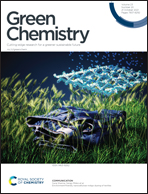Enhanced medium chain length-polyhydroxyalkanoate production by co-fermentation of lignin and holocellulose hydrolysates†
Abstract
Biological lignin conversion to medium chain length-polyhydroxyalkanoates (mcl-PHA) has recently emerged as an attractive alternative to petroleum-based plastics due to the renewable nature of lignin and the value-added applications of mcl-PHA. Previous reports suggested that addition of limited glucose can improve mcl-PHA accumulation in Pseudomonas putida KT2440 grown in lignin substrates. Herein, we propose a biorefinery process to systematically release lignin and sugars from lignocellulosic biomass and evaluate the potential of co-utilization of all biomass components for conversion to mcl-PHA. Our results indicate that a sequential treatment composed of acid pretreatment, enzymatic hydrolysis and alkaline treatment produces a suitable lignin stream for mcl-PHA production in engineered P. putida. In addition, the PHA titer could be increased by 71% when the lignin stream (AH) was combined with the enzymatic hydrolysate (EH) at a ratio of 75 : 25. Higher ratios of EH : AH negatively affect mcl-PHA accumulation as well as mixtures with sugars from the acid hydrolysate. The optimization of the fermentation conditions, including the inoculum (OD600) and substrate (soluble solid content (SSC)), was carried out by a central composite design. The optimal conditions were achieved at OD600 = 2.17 and SSC = 68.28 g L−1. Under these conditions, the titer increased 4.3 fold, achieving a mcl-PHA production of 1.38 g L−1. Lignin characterization before and after fermentation by nuclear magnetic resonance and gas chromatography showed that p-coumarates were mainly consumed during the fermentation for mcl-PHA production. Overall, this biorefinery strategy allowed us to increase mcl-PHA production by utilizing the different lignocellulosic fractions. Unlike previous studies, no model substrates were utilized at any stage of the fermentation process, representing a step forward towards process feasibility.



 Please wait while we load your content...
Please wait while we load your content...